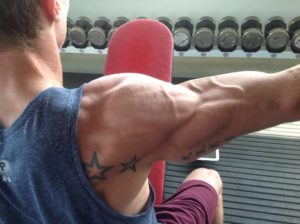The Ultra High-Rep Rotator Cuff Solution

Practical guidelines on keeping your shoulders strong and healthy
By Strength Sensei CP
Those who are serious about becoming bigger, stronger, and more powerful tend to emphasize on multi-joint movements such as squats, deadlifts, and bench presses. All good exercises, for certain, but often such focus causes us to overlook important smaller muscles. Case in point: the muscles that externally rotate the shoulders.
Not only do most trainers neglect these muscles of the rotator cuff, but when they do train them, they do so with inferior workout protocols. Let’s clear up some misconceptions.
First, the rotator cuff muscles contain about 60 percent fast-twitch muscle fibers. This makes sense, as these muscles need to be powerful decelerators so that athletes force longer with the accelerators for activities such as throwing a baseball or a javelin. In addition to athletic performance, the external rotator cuff muscles help maintain the integrity of the joint.
Many athletes I work with are extremely poor at isolating the rotator cuff muscles, which is why I often expose them with ultra high-rep sets for a short period, an approach promoted by my French colleagues Michael Gündhill and Frédéric Delavier. What do I mean by high reps?
Hold on, as I’m talking 30+ reps per set – even as many as 100 reps! Yes, such repetition protocols train primarily the slow-twitch fibers, but it’s often necessary to learn the correct motor pattern for these exercises. This is especially true for those who overemphasize the bench press.
 For untrained individuals, a period of higher-rep sets may be necessary when performing exercises that work the rotator cuff muscles of the shoulders.
For untrained individuals, a period of higher-rep sets may be necessary when performing exercises that work the rotator cuff muscles of the shoulders.
I must emphasize that this phase is brief, about three weeks. From here, I alternated between phases of higher reps (accumulation) and lower reps (intensification). In practical terms (as the range of motion of rotator cuff exercises are relatively short), a two-week phase of 8-12 reps per set could be alternated with a two-week phase of 6-8 reps per set.
I must also emphasize that it’s important to train the external rotator cuff muscles from a variety of angles, and cables and free weights are better than bands. With bands, the overload is only achieved at the end range of motion; it’s best to use many types of exercises that work all areas of the strength curve of a muscle.
A chain is only as strong as its weakness link, so give the external rotators of the shoulders the attention they deserve! (SS)
— Lead photo by Miloš Šarčev
